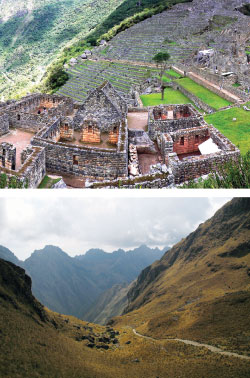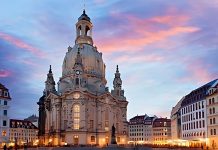Go back in time with a trip to one or all of these three destinations, all favourites of history buffs around the globe. We take a look beyond the typical Great Wall of China, forts in India and castles in Europe.
Petra, Jordan
 The Low-down: The giant, red mountains and vast mausoleums of a departed race have nothing in common with modern civilisation and are appreciated as one of the greatest wonders ever wrought by nature and man. Nothing really prepares you for this amazing place. Petra is without a doubt Jordan’s most valuable treasure and greatest tourist attraction. It is a vast, unique city, carved into the sheer rock face by the Nabataeans, an industrious Arab people who settled here more than 2,000 years ago.
The Low-down: The giant, red mountains and vast mausoleums of a departed race have nothing in common with modern civilisation and are appreciated as one of the greatest wonders ever wrought by nature and man. Nothing really prepares you for this amazing place. Petra is without a doubt Jordan’s most valuable treasure and greatest tourist attraction. It is a vast, unique city, carved into the sheer rock face by the Nabataeans, an industrious Arab people who settled here more than 2,000 years ago.
X-Factor: The Treasury is merely the first of the many wonders that make up Petra. You will need at least four or five days to really explore everything here. As you enter the Petra valley you will be overwhelmed by the natural beauty of this place and its outstanding architectural achievements. There are hundreds of elaborate rock-cut tombs with intricate designs. Here also is a massive Nabataean-built, Roman-style theatre, which could seat 3,000 people. There are obelisks, temples, sacrificial altars and colonnaded streets, and high above, overlooking the valley, is the impressive Ad-Deir Monastery — a flight of 800 rock-cut steps takes you there.
Best For: Photographers. Sights are at their best in early morning and late afternoon; when the sun warms the multicoloured stones, you can view the majesty of Petra as it was seen first when rediscovered in 1812 after being lost for almost 300 years. Share the excitement the Swiss explorer Johann Ludwig Burckhardt would have felt on his first visit as you enter the narrow gorge of Al-Siq, the secret entrance to Petra. After winding down this great natural cleft for over a kilometre, the sudden impact of the view of the Treasury is as strong every time.
Machu Picchu, Peru
 The Low-down: The Incan built structure has been deemed “Lost Cities” — unknown until its relatively recent discovery in 1911. It’s no wonder Machu Picchu is Peru’s most-visited site. Dating to the mid-1400s, it is a marvel of mortar-free limestone architecture perched on a high plateau deep in the Amazonian jungle. It is tangible evidence of the urban Inca Empire at the peak of its power and achievement. The complex of palaces and plazas, temples and homes may have been built as a ceremonial site, a military stronghold, or a retreat for ruling elites. The ruins lie on a high ridge, surrounded on three sides by the windy, turbulent Urubamba River some 2,000 feet below.
The Low-down: The Incan built structure has been deemed “Lost Cities” — unknown until its relatively recent discovery in 1911. It’s no wonder Machu Picchu is Peru’s most-visited site. Dating to the mid-1400s, it is a marvel of mortar-free limestone architecture perched on a high plateau deep in the Amazonian jungle. It is tangible evidence of the urban Inca Empire at the peak of its power and achievement. The complex of palaces and plazas, temples and homes may have been built as a ceremonial site, a military stronghold, or a retreat for ruling elites. The ruins lie on a high ridge, surrounded on three sides by the windy, turbulent Urubamba River some 2,000 feet below.
X-Factor: Hikers, tourists, and the early explorers describe similar emotions as they climb their way through the Inca Trail. Many call the experience magical. Glancing out from the Funerary Rock Hut on all the temples, fields, terraces and baths seems to take you to another time. Blending in with the hillside itself, many say the area creates a seamless and elegant green paradise, making it a must for anyone who travels to Peru. Despite this great tourist influx, the site manages to retain its air of grandeur and mystery.
Best For: The adventurous. Although you can get there via train from Cusco, there is a more daring way to get there. If you aren’t faint-hearted, make the trip on foot via a multi-day hiking trail — you’ll travel through deep Andean gullies and enjoy stunning views.
Angkor, Cambodia
 The Low-down: It’s an uphill-downhill journey of emotions that you will experience when you take a trip to this unique site. You are either floating in a realm of spirituality at Angkor Wat mesmerised by its heathenish aura; or you are sinking into the depths of what could be defined as hell on earth at Tuol Sleng which reeks of the depressing past of the Khmer Rouge. Angkor, in Cambodia’s Northern Province of Siem Reap, is one of the most important archaeological sites of Southeast Asia. It extends over approximately 400 square kilometres and consists of scores of temples, hydraulic structures and communication routes. With impressive monuments, several different ancient urban plans and large water reservoirs, the site is a unique concentration of features testifying to an exceptional civilisation.
The Low-down: It’s an uphill-downhill journey of emotions that you will experience when you take a trip to this unique site. You are either floating in a realm of spirituality at Angkor Wat mesmerised by its heathenish aura; or you are sinking into the depths of what could be defined as hell on earth at Tuol Sleng which reeks of the depressing past of the Khmer Rouge. Angkor, in Cambodia’s Northern Province of Siem Reap, is one of the most important archaeological sites of Southeast Asia. It extends over approximately 400 square kilometres and consists of scores of temples, hydraulic structures and communication routes. With impressive monuments, several different ancient urban plans and large water reservoirs, the site is a unique concentration of features testifying to an exceptional civilisation.
X-Factor: Temples such as Angkor Wat, the Bayon, Preah Khan and Ta Prohm, exemplars of Khmer architecture, are closely linked to their geographical context as well as being imbued with symbolic significance. What is believed to be the world’s largest religious building, the mother of all temples, Angkor Wat is the heart and soul of Cambodia. It is the national symbol, the epicentre of Khmer civilisation and a source of fierce national pride. Soaring skyward and surrounded by a moat that would make its European castle counterparts blush, it is one of the most inspired and spectacular monuments ever conceived by the human mind. Unlike the other Angkor monuments, it was never abandoned to the elements and has been in virtually continuous use since it was built
Best For: Art enthusiasts. Angkor Wat is famous for having more than 3,000 beguiling apsaras (heavenly nymphs) carved into its walls. Each of them is unique, and there are 37 different hairstyles to check out.




































